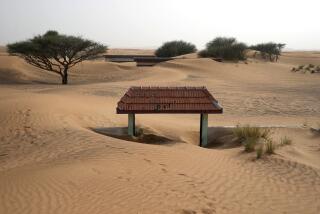Enigma of the Desert : Jordan’s Ancient City of Jawa Poses Mystery
- Share via
JAWA, Jordan — The canals of Jawa still run with water as they were designed to do 5,000 years ago, but who built them and the city itself remain mysteries.
“We have this apparent enigma out there in the middle of the semi-arid region,” said Sven Helms, a Canadian archeologist who excavated Jawa in the 1970s.
Helms used pottery and other evidence to approximate its era at 3300 BC--about 600 years before Egypt’s pyramids were built.
Nothing like it as old has been found in such a place. And nobody yet knows of a nearby civilization with the technology to build its well-surveyed walls or its seven miles of canals.
Few Researchers
Helms said that part of the reason may be that few researchers have studied the deserts between Mesopotamia and Palestine.
In a 1981 book, he theorized that Jawa might have been built by refugees from an early urban culture in Mesopotamia or Syria.
But in a recent interview, he said he now tends to believe that Jawa might have been the outpost of a society based near modern Damascus, Syria’s capital.
The remains of the prehistoric city stand atop a hill at the edge of eastern Jordan’s scorched volcanic desert, close to the Syrian border and about 80 miles east of the Jordan River. The great oasis of Azraq is 30 miles south.
Once Less Arid
What now seems a rocky, dusty land was probably slightly more verdant 5,000 years ago, Helms said.
“You have to imagine the place looking not so horrible as it does today,” he said.
He calculated that 3,000 to 5,000 people could have lived in primitive, rounded houses on the 25-acre site, protected by two rings of black basalt walls.
Bones and burned remains indicated that Jawa’s people raised and ate cattle, sheep, cereal grains and vegetables. Helms pointed to faint traces of rock walls that apparently served as irrigation systems.
No Water Supply
Since the area had no regular source of water, the Jawaites engineered a sophisticated system of diversion dams, canals and pools to trap and store seasonal floodwaters that raced down a gulch called the Wadi Rajil.
Bedouin Arabs still maintain some of the canals, and one group recently cemented the bed of an ancient pool to provide water for goats.
But the people who created this city vanished soon after they built it, with relatively few traces.
“I don’t think they stayed more than 50 years, if that, so that’s another mystery,” Helms said.
He found signs of conflict in the walls of Jawa, apparently battered down and rebuilt in places. He speculated that the water-hungry Bedouin nomads may have clashed with those who built the city.
“If you create a place like this with water for the dry years, you’re going to attract Bedouin,” he said. “And sooner or later, you’re going to have to fight them.”
More to Read
Sign up for Essential California
The most important California stories and recommendations in your inbox every morning.
You may occasionally receive promotional content from the Los Angeles Times.













